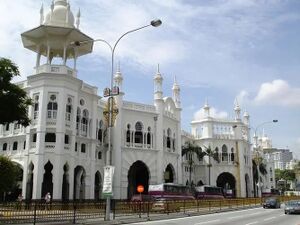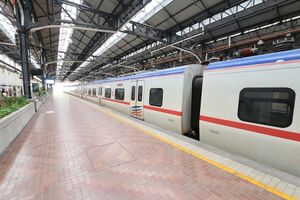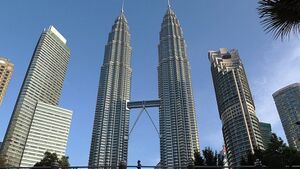Kuala Lum
| Kuala Lum | |||||
|---|---|---|---|---|---|
| Japanese Name | クアラルン | ||||
| Weapon | |||||
| Race | Human | ||||
| Nationality | |||||
| Birthday | March 26 | ||||
| Constellation | Aries | ||||
| Talents | Relaxing others with tea | ||||
| Likes | Tea | ||||
| Dislikes | Unfriendly atmospheres | ||||
| Strengths | Able to serve good tea | ||||
| Weaknesses | Settles into dark, confined spaces and stay immobile | ||||
| Hobbies | Tea cultivation, High tea | ||||
I grew up inside a box from a very young age, so I don't know much about a lot of things~ But I do studied to take over the family business one day, that's why I know a lot about tea cultivation and management~♪
Layers
| Icon | Title | Release Date | Where to Obtain |
|---|---|---|---|
| [Lady in the Box] Kuala Lum | 2021 August 30 (EN) | Premium Gacha | |
| [Joyful Tea Party] Kuala Lum | 2021 December 1 (EN) | [El Dorado on the Sand] Pick Up Gacha, Premium Gacha | |
| [Elegant Stroll] Kuala Lum | 2021 December 24 | [Nishiki Talk With Sake 'ska] Limited Gacha | |
| [Comfort Overflowing from a Tea Cup] Kuala Lum | 2022 June 1 (EN) | [A Journey of Good Encounters] Pick Up Gacha, Premium Gacha | |
| [Miracle☆Magical☆] Kuala Lum | 2022 September 30 | 2nd Anniversary Limited Gacha 3 |
Owned Skills
Trivia
- Kuala Lum's axe handle design resembles the Petronas Twin Towers, the world's tallest twin skyscrapers.
- Kuala Lum's liking for tea references the tea industry of Malaysia in the British colonial era. West Malaysia's tea drinking culture has its origins in the British colonial days. The first tea plantation was established in Malaysia during the British colonization, in Cameron Highlands.
- The tea company that is owned by Kuala Lum's residence is possibly a reference to the BOH Plantations Sdn. Bhd. - the largest black tea manufacturer in Malaysia. The headquarters of the tea company is situated in Kuala Lumpur.
- The building in the background of [Comfort Overflowing from a Tea Cup] resembles the Carcosa Seri Negara Museum, originally built as the official residence and guest house of the British High Commissioner in Malaya, figured prominently in the Malaysian independence movement.
- Afternoon tea can be seen in [Joyful Tea Party] and [Comfort Overflowing from a Tea Cup]. Commonly served by hotels in the city of Kuala Lumpur, it consists of thinly-sliced bread and butter, delicate sandwiches and usually local pastries. Scones (with clotted cream and jam) would also be served alongside washings of tea.
- Kuala Lum dances the joget in the [Comfort Overflowing from a Tea Cup] victory animation. The dance is one of the most popular folk dances in Malaysia and normally performed by couples in cultural festivals, weddings and other social functions.
Counterpart
The Kuala Lumpur railway station (Stesen keretapi Kuala Lumpur) is a railway station located in Kuala Lumpur, Malaysia. Construction began in 1910 and was fully completed in 1917, it replaced an older station on the same site. The station was Kuala Lumpur's railway hub in the city for the Federated Malay States Railways and its successor Keretapi Tanah Melayu, before Kuala Lumpur Sentral assumed much of its role in 2001. The station is notable for its architecture, adopting a mixture of Eastern and Western designs.
Arthur Benison Hubback, a British Architectural Assistant to the Director of Public Works, undertook the design of the station. He incorporated the unique Anglo-Asian architecture in the region on the station's design. The "Neo-Moorish/Mughal/Indo-Saracenic/Neo-Saracenic" style was not uncommon at the time. Similar structures, such as the Sultan Abdul Samad Building (credited to A.C. Norman but largely designed by R.A.J. Bidwell, completed 1897), the Old City Hall (designed by A.B. Hubback, completed 1904) and the Jamek Mosque (designed by A.B. Hubback, completed 1909), pre-date Kuala Lumpur station.
After the diversion of long-distance intercity rail traffic less than a kilometer south to Kuala Lumpur Sentral on 15 April 2001, the original station's importance diminished. While intercity trains continue to pass the station, they no longer stop there, relegating the station to being a stop for Komuter and goods services. As a result of declining passenger traffic and patronage, redundant station facilities, such as manned ticket counters for intercity services, station offices and rented businesses spaces, were decommissioned or slowly vacated.
The station contains three platforms serving four railway tracks, consisting of two side platforms (platforms 1 and 4) on both sides and one island platform (platforms 2 and 3) in between. The numbered designations originally applied to the lengths of both the original and extended platforms from the 1986 renovation until the introduction of Komuter in 1995, when extensions of the original platforms 2 and 3 were assigned additional "a" suffixes, i.e. platforms 2a and 3a, while designations for platforms 1 and 4 remain unchanged.
The platforms are covered by large steel-framed shelters, which were initially shorter during the station's early operation. The roofs were originally glazed, and were partially opened to allow smoke from steam locomotives to escape; corrugated roof sheets served as replacements later in the station's life. The sides of the platforms not adjoining the main building are surrounded by walls constructed in the same style as the main building. The platforms and main building are linked to each other via two underground passageways. Wikipedia
The Petronas Towers, also known as the Petronas Twin Towers and the KLCC Twin Towers, are 88-storey supertall skyscrapers in Kuala Lumpur, Malaysia. At 451.9 metres (1,483 feet), they are the world's tallest twin skyscrapers. Between 1998 and 2004, they were the tallest buildings in the world. The Petronas Towers remained as the tallest buildings in Malaysia until 2021, when they were surpassed by Merdeka 118. The Petronas Towers are a major landmark of Kuala Lumpur, along with the nearby Kuala Lumpur Tower and Merdeka 118, and are visible in many places across the city.
The towers were designed by Argentine-American architect César Pelli. A distinctive postmodern style was chosen to create a 21st-century icon for Kuala Lumpur, Malaysia. The cross section of the Petronas Towers is based on a Rub el Hizb, albeit with circular sectors similar to the bottom part of the Qutub Minar. The Petronas Towers' structural system is a tube in tube design, invented by architect Fazlur Rahman Khan. Applying a tube-structure for extreme tall buildings is a common phenomenon. The 88-floor towers are constructed largely of reinforced concrete, with a steel and glass facade designed to resemble motifs found in Islamic art, a reflection of Malaysia's Muslim religion. Another Islamic influence on the design is that the cross section of the towers is based on a Rub el Hizb, albeit with circular sectors added to meet office space requirements. The circular sectors is similar to the bottom part of the Qutub Minar. Wikipedia
Map
Gallery
- Pages using Tabber parser tag
- Pages using DynamicPageList3 parser tag
- Weapon Axe
- Human
- Flamarine
- Aries
- Element Cut
- Element Wind
- Element Water
- Element Fire
- Train Knights
- Malaysia
















